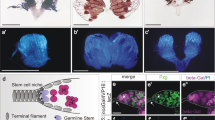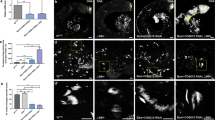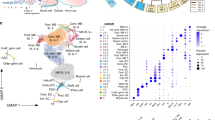Abstract
A limited number of adult stem cells (SCs) maintain the homoestasis of different tissues through the lifetime of the individual by generating differentiating daughters and renewing themselves. Errors in the SC division rate or in the fine balance between self-renewal and differentiation might result in tissue overgrowth or depletion, two potentially lethal conditions. A few types of SCs have been identified in Drosophila. These include the SCs of the adult intestine and malpighian tubes, (Micchelli and Perrimon, 2006; Ohlstein and Spradling, 2006; Singh et al., 2007), the prohematocytes that maintain the population of cells involved in the immunoresponse (Lanot et al., 2001; Lemaitre and Hoffmann, 2007), the SC of the follicle epithelia in the ovary (Nystul and Spradling, 2007), germ line SCs (GSCs) of both sexes (Fuller and Spradling, 2007) and neuroblasts (NBs), the fly neural SCs (Yu et al., 2006; Chia et al., 2008; Knoblich, 2008). Drosophila SCs have proved a fruitful model system to unveil some aspects of the molecular logic that sustains SC function. This review focuses on results obtained in the last few years from the study of NBs, particularly from the standpoint of the possible functional connection between asymmetric SC division and cancer.
This is a preview of subscription content, access via your institution
Access options
Subscribe to this journal
Receive 50 print issues and online access
$259.00 per year
only $5.18 per issue
Buy this article
- Purchase on Springer Link
- Instant access to full article PDF
Prices may be subject to local taxes which are calculated during checkout


Similar content being viewed by others
References
Albertson R, Doe CQ . (2003). Dlg, Scrib and Lgl regulate neuroblast cell size and mitotic spindle asymmetry. Nat Cell Biol 5: 166–170.
Almeida MS, Bray SJ . (2005). Regulation of post-embryonic neuroblasts by Drosophila Grainyhead. Mech Dev 122: 1282–1293.
Atwood SX, Chabu C, Penkert RR, Doe CQ, Prehoda KE . (2007). Cdc42 acts downstream of Bazooka to regulate neuroblast polarity through Par-6 aPKC. J Cell Sci 120: 3200–3206.
Basto R, Brunk K, Vinadogrova T, Peel N, Franz A, Khodjakov A et al. (2008). Centrosome amplification can initiate tumorigenesis in flies. Cell 133: 1032–1042.
Basto R, Lau J, Vinogradova T, Gardiol A, Woods CG, Khodjakov A et al. (2006). Flies without centrioles. Cell 125: 1375–1386.
Beachy PA, Karhadkar SS, Berman DM . (2004). Tissue repair and stem cell renewal in carcinogenesis. Nature 432: 324–331.
Bello B, Reichert H, Hirth F . (2006). The brain tumor gene negatively regulates neural progenitor cell proliferation in the larval central brain of Drosophila. Development 133: 2639–2648.
Bello BC, Izergina N, Caussinus E, Reichert H . (2008). Amplification of neural stem cell proliferation by intermediate progenitor cells in Drosophila brain development. Neural Develop 3: 5.
Betschinger J, Mechtler K, Knoblich JA . (2003). The Par complex directs asymmetric cell division by phosphorylating the cytoskeletal protein Lgl. Nature 422: 326–330.
Betschinger J, Mechtler K, Knoblich JA . (2006). Asymmetric segregation of the tumor suppressor brat regulates self-renewal in Drosophila neural stem cells. Cell 124: 1241–1253.
Bilder D . (2004). Epithelial polarity and proliferation control: links from the Drosophila neoplastic tumor suppressors. Genes Dev 18: 1909–1925.
Boone JQ, Doe CQ . (2008). Identification of Drosophila type II neuroblast lineages containing transit amplifying ganglion mother cells. Dev Neurobiol 68: 1185–1195.
Boveri T . (2008). Concerning the origin of malignant tumours by Theodor Boveri. Translated and annotated by Henry Harris. J Cell Sci 121: 1–84.
Bowman SK, Neumuller RA, Novatchkova M, Du Q, Knoblich JA . (2006). The Drosophila NuMA Homolog Mud regulates spindle orientation in asymmetric cell division. Dev Cell 10: 731–742.
Bowman SK, Rolland V, Betschinger J, Kinsey KA, Emery G, Knoblich JA . (2008). The tumor suppressors Brat and Numb regulate transit-amplifying neuroblast lineages in Drosophila. Dev Cell 14: 535–546.
Brawley C, Matunis E . (2004). Regeneration of male germline stem cells by spermatogonial dedifferentiation in vivo. Science 304: 1331–1334.
Broadus J, Doe CQ . (1997). Extrinsic cues, intrinsic cues and microfilaments regulate asymmetric protein localization in Drosophila neuroblasts. Curr Biol 7: 827–835.
Broadus J, Fuerstenberg S, Doe CQ . (1998). Staufen-dependent localization of prospero mRNA contributes to neuroblast daughter-cell fate. Nature 391: 792–795.
Castellanos E, Dominguez P, Gonzalez C . (2008). Centrosome dysfunction in Drosophila neural stem cells causes tumors that sre not due to genome instability. Curr Biol 18: 1209–1214.
Caussinus E, Gonzalez C . (2005). Induction of tumor growth by altered stem-cell asymmetric division in Drosophila melanogaster. Nat Genet 37: 1125–1129.
Caussinus E, Hirth F . (2007). Asymmetric stem cell division in development and cancer. Prog Mol Subcell Biol 45: 205–225.
Ceron J, Tejedor FJ, Moya F . (2006). A primary cell culture of Drosophila postembryonic larval neuroblasts to study cell cycle and asymmetric division. Eur J Cell Biol 85: 567–575.
Chabu C, Doe CQ . (2008). Dap160/intersectin binds and activates aPKC to regulate cell polarity and cell cycle progression. Development 135: 2739–2746.
Chia W, Somers WG, Wang H . (2008). Drosophila neuroblast asymmetric divisions: cell cycle regulators, asymmetric protein localization, and tumorigenesis. J Cell Biol 180: 267–272.
Choksi SP, Southall TD, Bossing T, Edoff K, de Wit E, Fischer BE et al. (2006). Prospero acts as a binary switch between self-renewal and differentiation in Drosophila neural stem cells. Dev Cell 11: 775–789.
Doe CQ . (2008). Neural stem cells: balancing self-renewal with differentiation. Development 135: 1575–1587.
Doe CQ, Chu-LaGraff Q, Wright DM, Scott MP . (1991). The prospero gene specifies cell fates in the Drosophila central nervous system. Cell 65: 451–464.
Duensing S . (2005). A tentative classification of centrosome abnormalities in cancer. Cell Biol Int 29: 352–359.
Dumstrei K, Wang F, Hartenstein V . (2003). Role of DE-cadherin in neuroblast proliferation, neural morphogenesis, and axon tract formation in Drosophila larval brain development. J Neurosci 23: 3325–3335.
Ebens AJ, Garren H, Cheyette BN, Zipursky SL . (1993). The Drosophila anachronism locus: a glycoprotein secreted by glia inhibits neuroblast proliferation. Cell 74: 15–27.
Feiguin F, Llamazares S, Gonzalez C . (1998). Methods in Drosophila cell cycle biology. Curr Top Dev Biol 36: 279–291.
Frank DJ, Edgar BA, Roth MB . (2002). The Drosophila melanogaster gene brain tumor negatively regulates cell growth and ribosomal RNA synthesis. Development 129: 399–407.
Fuller MT, Spradling AC . (2007). Male and female Drosophila germline stem cells: two versions of immortality. Science 316: 402–404.
Gateff E . (1978). Malignant neoplasms of genetic origin in Drosophila melanogaster. Science 200: 1448–1459.
Gateff E, Schneiderman HA . (1967). Developmental studies of a new mutant of Drosophila melanogaster: Lethal malignant brain tumor (l(2)gl 4). Am Zool 7: 760.
Golubovsky MD, Weisman NY, Arbeev KG, Ukraintseva SV, Yashin AI . (2006). Decrease in the lgl tumor suppressor dose in Drosophila increases survival and longevity in stress conditions. Exp Gerontol 41: 819–827.
Gonczy P . (2008). Mechanisms of asymmetric cell division: flies and worms pave the way. Nat Rev Mol Cell Biol 9: 355–366.
Gonzalez C . (2007). Spindle orientation, asymmetric division and tumour suppression in Drosophila stem cells. Nat Rev Genet 8: 462–472.
Hanahan D, Weinberg RA . (2000). The hallmarks of cancer. Cell 100: 57–70.
Harris H . (2005). A long view of fashions in cancer research. Bioessays 27: 833–838.
Harshbarger JC, Taylor RL. (1968). Neoplasms of insects. Annual Review of Entomology 13: 159–190.
Humbert P, Russell S, Richardson H . (2003). Dlg, Scribble and Lgl in cell polarity, cell proliferation and cancer. Bioessays 25: 542–553.
Huntly BJ, Gilliland DG . (2005). Leukaemia stem cells and the evolution of cancer-stem-cell research. Nat Rev Cancer 5: 311–321.
Ikeshima-Kataoka H, Skeath JB, Nabeshima Y, Doe CQ, Matsuzaki F . (1997). Miranda directs Prospero to a daughter cell during Drosophila asymmetric divisions. Nature 390: 625–629.
Isshiki T, Pearson B, Holbrook S, Doe CQ . (2001). Drosophila neuroblasts sequentially express transcription factors which specify the temporal identity of their neuronal progeny. Cell 106: 511–521.
Ito K, Hotta Y . (1992). Proliferation pattern of postembryonic neuroblasts in the brain of Drosophila melanogaster. Dev Biol 149: 134–148.
Izumi Y, Ohta N, Hisata K, Raabe T, Matsuzaki F . (2006). Drosophila Pins-binding protein Mud regulates spindle-polarity coupling and centrosome organization. Nat Cell Biol 8: 586–593.
Izumi Y, Ohta N, Itoh-Furuya A, Fuse N, Matsuzaki F . (2004). Differential functions of G protein and Baz-aPKC signaling pathways in Drosophila neuroblast asymmetric division. J Cell Biol 164: 729–738.
Kai T, Spradling A . (2004). Differentiating germ cells can revert into functional stem cells in Drosophila melanogaster ovaries. Nature 428: 564–569.
Kaltschmidt JA, Davidson CM, Brown NH, Brand AH . (2000). Rotation and asymmetry of the mitotic spindle direct asymmetric cell division in the developing central nervous system. Nat Cell Biol 2: 7–12.
Kelly PN, Dakic A, Adams JM, Nutt SL, Strasser A . (2007). Tumor growth need not be driven by rare cancer stem cells. Science 317: 337.
Knoblich JA . (2008). Mechanisms of asymmetric stem cell division. Cell 132: 583–597.
Knoblich JA, Jan LY, Jan YN . (1995). Asymmetric segregation of Numb and Prospero during cell division. Nature 377: 624–627.
Kraut R, Chia W, Jan LY, Jan YN, Knoblich JA . (1996). Role of inscuteable in orienting asymmetric cell divisions in Drosophila. Nature 383: 50–55.
Lanot R, Zachary D, Holder F, Meister M . (2001). Postembryonic hematopoiesis in Drosophila. Dev Biol 230: 243–257.
Le Borgne R, Bardin A, Schweisguth F . (2005). The roles of receptor and ligand endocytosis in regulating Notch signaling. Development 132: 1751–1762.
Lee CY, Andersen RO, Cabernard C, Manning L, Tran KD, Lanskey MJ et al. (2006a). Drosophila Aurora-A kinase inhibits neuroblast self-renewal by regulating aPKC/Numb cortical polarity and spindle orientation. Genes Dev 20: 3464–3474.
Lee CY, Robinson KJ, Doe CQ . (2006b). Lgl, Pins and aPKC regulate neuroblast self-renewal versus differentiation. Nature 439: 594–598.
Lee CY, Wilkinson BD, Siegrist SE, Wharton RP, Doe CQ . (2006c). Brat is a Miranda cargo protein that promotes neuronal differentiation and inhibits neuroblast self-renewal. Dev Cell 10: 441–449.
Lemaitre B, Hoffmann J . (2007). The host defense of Drosophila melanogaster. Annu Rev Immunol 25: 697–743.
Lengauer C, Kinzler KW, Vogelstein B . (1998). Genetic instabilities in human cancers. Nature 396: 643–649.
Li L, Vaessin H . (2000). Pan-neural Prospero terminates cell proliferation during Drosophila neurogenesis. Genes Dev 14: 147–151.
Li P, Yang X, Wasser M, Cai Y, Chia W . (1997). Inscuteable and Staufen mediate asymmetric localization and segregation of prospero RNA during Drosophila neuroblast cell divisions. Cell 90: 437–447.
Loop T, Leemans R, Stiefel U, Hermida L, Egger B, Xie F et al. (2004). Transcriptional signature of an adult brain tumor in Drosophila. BMC Genomics 5: 24.
Lu B, Rothenberg M, Jan LY, Jan YN . (1998). Partner of Numb colocalizes with Numb during mitosis and directs Numb asymmetric localization in Drosophila neural and muscle progenitors. Cell 95: 225–235.
Lucas EP, Raff JW . (2007). Maintaining the proper connection between the centrioles and the pericentriolar matrix requires Drosophila centrosomin. J Cell Biol 178: 725–732.
Maurange C, Cheng L, Gould AP . (2008). Temporal transcription factors and their targets schedule the end of neural proliferation in Drosophila. Cell 133: 891–902.
Mechler BM, Strand D, Kalmes A, Merz R, Schmidt M, Torok I . (1991). Drosophila as a model system for molecular analysis of tumorigenesis. Environ Health Perspect 93: 63–71.
Micchelli CA, Perrimon N . (2006). Evidence that stem cells reside in the adult Drosophila midgut epithelium. Nature 439: 475–479.
Nigg EA . (2006). Origins and consequences of centrosome aberrations in human cancers. Int J Cancer 119: 2717–2723.
Nystul T, Spradling A . (2007). An epithelial niche in the Drosophila ovary undergoes long-range stem cell replacement. Cell Stem Cell 1: 277–285.
Ohlstein B, Spradling A . (2006). The adult Drosophila posterior midgut is maintained by pluripotent stem cells. Nature 439: 470–474.
Ohshiro T, Yagami T, Zhang C, Matsuzaki F . (2000). Role of cortical tumour-suppressor proteins in asymmetric division of Drosophila neuroblast. Nature 408: 593–596.
Park Y, Rangel C, Reynolds MM, Caldwell MC, Johns M, Nayak M et al. (2003). Drosophila perlecan modulates FGF and hedgehog signals to activate neural stem cell division. Dev Biol 253: 247–257.
Parmentier ML, Woods D, Greig S, Phan PG, Radovic A, Bryant P et al. (2000). Rapsynoid/partner of inscuteable controls asymmetric division of larval neuroblasts in Drosophila. J Neurosci 20: RC84.
Pearson BJ, Doe CQ . (2003). Regulation of neuroblast competence in Drosophila. Nature 425: 624–628.
Peng CY, Manning L, Albertson R, Doe CQ . (2000). The tumour-suppressor genes lgl and dlg regulate basal protein targeting in Drosophila neuroblasts. Nature 408: 596–600.
Petronczki M, Knoblich JA . (2001). DmPAR-6 directs epithelial polarity and asymmetric cell division of neuroblasts in Drosophila. Nat Cell Biol 3: 43–49.
Potter CJ, Turenchalk GS, Xu T . (2000). Drosophila in cancer research. An expanding role. Trends Genet 16: 33–39.
Rebollo E, Sampaio P, Januschke J, Llamazares S, Varmark H, Gonzalez C . (2007). Functionally unequal centrosomes drive spindle orientation in asymmetrically dividing Drosophila neural stem cells. Dev Cell 12: 467–474.
Remensberger P . (1968). Cytologische und histologische Untersuchungen an Zellstämmen von Drosophila melanogaster nach Dauerkultur in vivo. Chromosoma 23: 386–417.
Reya T, Morrison SJ, Clarke MF, Weissman IL . (2001). Stem cells, cancer, and cancer stem cells. Nature 414: 105–111.
Rolls MM, Albertson R, Shih HP, Lee CY, Doe CQ . (2003). Drosophila aPKC regulates cell polarity and cell proliferation in neuroblasts and epithelia. J Cell Biol 163: 1089–1098.
Rolls MM, Doe CQ . (2004). Baz, Par-6 and aPKC are not required for axon or dendrite specification in Drosophila. Nat Neurosci 7: 1293–1295.
Rusan NM, Peifer M . (2007). A role for a novel centrosome cycle in asymmetric cell division. J Cell Biol 177: 13–20.
Scadden DT . (2006). The stem-cell niche as an entity of action. Nature 441: 1075–1079.
Schaefer M, Shevchenko A, Shevchenko A, Knoblich JA . (2000). A protein complex containing Inscuteable and the Galpha-binding protein Pins orients asymmetric cell divisions in Drosophila. Curr Biol 10: 353–362.
Schober M, Schaefer M, Knoblich JA . (1999). Bazooka recruits Inscuteable to orient asymmetric cell divisions in Drosophila neuroblasts. Nature 402: 548–551.
Schweisguth F . (2004). Regulation of notch signaling activity. Curr Biol 14: R129–R138.
Shen CP, Jan LY, Jan YN . (1997). Miranda is required for the asymmetric localization of Prospero during mitosis in Drosophila. Cell 90: 449–458.
Siegrist SE, Doe CQ . (2005). Microtubule-induced Pins/Galphai cortical polarity in Drosophila neuroblasts. Cell 123: 1323–1335.
Siller KH, Cabernard C, Doe CQ . (2006). The NuMA-related Mud protein binds Pins and regulates spindle orientation in Drosophila neuroblasts. Nat Cell Biol 8: 594–600.
Singh SR, Liu W, Hou SX . (2007). The adult Drosophila malpighian tubules are maintained by multipotent stem cells. Cell Stem Cell 1: 191–203.
Smith CA, Lau KM, Rahmani Z, Dho SE, Brothers G, She YM et al. (2007). aPKC-mediated phosphorylation regulates asymmetric membrane localization of the cell fate determinant Numb. EMBO J 26: 468–480.
Sonoda J, Wharton RP . (2001). Drosophila brain tumor is a translational repressor. Genes Dev 15: 762–773.
Speicher S, Fischer A, Knoblich J, Carmena A . (2008). The PDZ protein canoe regulates the asymmetric division of Drosophila neuroblasts and muscle progenitors. Curr Biol 18: 831–837.
Tio M, Udolph G, Yang X, Chia W . (2001). cdc2 links the Drosophila cell cycle and asymmetric division machineries. Nature 409: 1063–1067.
Truman JW, Bate M . (1988). Spatial and temporal patterns of neurogenesis in the central nervous system of Drosophila melanogaster. Dev Biol 125: 145–157.
Wang H, Ouyang Y, Somers WG, Chia W, Lu B . (2007). Polo inhibits progenitor self-renewal and regulates Numb asymmetry by phosphorylating Pon. Nature 449: 96–100.
Wang H, Somers GW, Bashirullah A, Heberlein U, Yu F, Chia W . (2006). Aurora-A acts as a tumor suppressor and regulates self-renewal of Drosophila neuroblasts. Genes Dev 20: 3453–3463.
Watson KL, Justice RW, Bryant PJ . (1994). Drosophila in cancer research: the first fifty tumor suppressor genes. J Cell Sci Suppl 18: 19–33.
Wodarz A . (2005). Molecular control of cell polarity and asymmetric cell division in Drosophila neuroblasts. Curr Opin Cell Biol 17: 475–481.
Wodarz A, Ramrath A, Kuchinke U, Knust E . (1999). Bazooka provides an apical cue for Inscuteable localization in Drosophila neuroblasts. Nature 402: 544–547.
Woodhouse E, Hersperger E, Shearn A . (1998). Growth, metastasis, and invasiveness of Drosophila tumors caused by mutations in specific tumor suppressor genes. Dev Genes Evol 207: 542–550.
Wu CF, Suzuki N, Poo MM . (1983). Dissociated neurons from normal and mutant Drosophila larval central nervous system in cell culture. J Neurosci 3: 1888–1899.
Yu F, Cai Y, Kaushik R, Yang X, Chia W . (2003). Distinct roles of Galphai and Gbeta13F subunits of the heterotrimeric G protein complex in the mediation of Drosophila neuroblast asymmetric divisions. J Cell Biol 162: 623–633.
Yu F, Kuo CT, Jan YN . (2006). Drosophila neuroblast asymmetric cell division: recent advances and implications for stem cell biology. Neuron 51: 13–20.
Zhu CC, Boone JQ, Jensen PA, Hanna S, Podemski L, Locke J et al. (2008). Drosophila Activin- and the Activin-like product Dawdle function redundantly to regulate proliferation in the larval brain. Development 135: 513–521.
Acknowledgements
This study was supported by EU and Spanish Grants: ONCASYM-037398 FP6, BFU2006-05813, SGR2005 Generalitat de Catalunya and Consolider-Ingenio2010 CENTROSOME_3D CSD2006-23.
Author information
Authors and Affiliations
Corresponding author
Rights and permissions
About this article
Cite this article
Januschke, J., Gonzalez, C. Drosophila asymmetric division, polarity and cancer. Oncogene 27, 6994–7002 (2008). https://doi.org/10.1038/onc.2008.349
Published:
Issue Date:
DOI: https://doi.org/10.1038/onc.2008.349
Keywords
This article is cited by
-
Tissue-resident stem cell activity: a view from the adult Drosophila gastrointestinal tract
Cell Communication and Signaling (2017)
-
Control of neural stem cell self-renewal and differentiation in Drosophila
Cell and Tissue Research (2015)
-
TRIM3, a tumor suppressor linked to regulation of p21Waf1/Cip1
Oncogene (2014)
-
Insights into brain development and disease from neurogenetic analyses in Drosophila melanogaster
Journal of Biosciences (2014)
-
Centrobin controls mother–daughter centriole asymmetry in Drosophila neuroblasts
Nature Cell Biology (2013)



